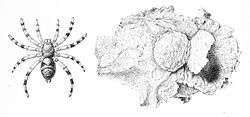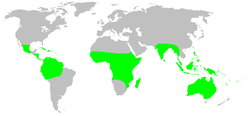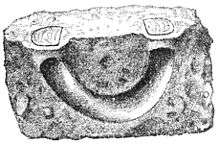Barychelidae
| Brushed-footed trap-door spiders | |
|---|---|
 | |
| Sason robustum with nest | |
| Scientific classification | |
| Kingdom: | Animalia |
| Phylum: | Arthropoda |
| Subphylum: | Chelicerata |
| Class: | Arachnida |
| Order: | Araneae |
| Suborder: | Opisthothelae |
| Infraorder: | Mygalomorphae |
| Family: | Barychelidae Simon, 1889[1] |
| Genera | |
|
See text. | |
| Diversity[2] | |
| 42 genera, c. 300 species | |
 | |

Barychelidae is a spider family with about 300 species in 42 genera. Its members are known as brushed trapdoor spiders.
Most spiders in this family build trapdoor burrows. There are some species that avoid flooding by plugging their nests. Others can avoid drowning by trapping air bubbles within the hairs covering their bodies. Some members of this group have a rake on the front surface of their chelicerae used for compacting burrow walls.[3]
The approximately 10 mm long Idioctis builds its about 5 cm deep burrow just below high tide level, and seals it with a thin trapdoor. The approximately 20 mm long Sipalolasma builds its burrow in rotted wood, with a hinged trapdoor at each end of the burrow.[4]
Like the Theraphosidae (tarantulas), they can run up glass. Some species can stridulate.[5] However, unlike stridulation in the theraphosid Selenocosmiinae, barychelid stridulation, based as it is on very weak lyra, is not audible to humans.
Distribution
Barychelids are found in Australia, New Caledonia, South America, Africa, Madagascar, India, New Guinea, and Pacific islands.[1]
Systematics
Genera
As of November 2015, the World Spider Catalog accepted the following genera:[6]
- Ammonius Thorell, 1899
- Atrophothele Pocock, 1903
- Aurecocrypta Raven, 1994
- Barycheloides Raven, 1994
- Barychelus Simon, 1889
- Cosmopelma Simon, 1889
- Cyphonisia Simon, 1889
- Cyrtogrammomma Pocock, 1895
- Diplothele O. Pickard-Cambridge, 1890
- Encyocrypta Simon, 1889
- Eubrachycercus Pocock, 1897
- Fijocrypta Raven, 1994
- Idioctis L. Koch, 1874
- Idiommata Ausserer, 1871
- Idiophthalma O. Pickard-Cambridge, 1877
- Mandjelia Raven, 1994
- Monodontium Kulczy?ski, 1908
- Moruga Raven, 1994
- Natgeogia Raven, 1994
- Neodiplothele Mello-Leitão, 1917
- Nihoa Raven & Churchill, 1992
- Orstom Raven, 1994
- Ozicrypta Raven, 1994
- Paracenobiopelma Feio, 1952
- Pisenor Simon, 1889
- Plagiobothrus Karsch, 1892
- Psalistops Simon, 1889
- Questocrypta Raven, 1994
- Rhianodes Raven, 1985
- Sason Simon, 1887
- Sasonichus Pocock, 1900
- Seqocrypta Raven, 1994
- Sipalolasma Simon, 1892
- Strophaeus Ausserer, 1875
- Synothele Simon, 1908
- Thalerommata Ausserer, 1875
- Tigidia Simon, 1892
- Trittame L. Koch, 1874
- Troglothele Fage, 1929
- Tungari Raven, 1994
- Zophorame Raven, 1990
- Zophoryctes Simon, 1902
See also
Footnotes
- 1 2 "Family: Barychelidae Simon, 1889". World Spider Catalog. Natural History Museum Bern. Retrieved 2015-11-09.
- ↑ "Currently valid spider genera and species". World Spider Catalog. Natural History Museum Bern. Archived from the original on 2015-11-03. Retrieved 2015-11-09.
- ↑ Herbert W. Levi and Lorna R. Levi. Spiders and Their Kin. p. 20.
- ↑ Murphy, Frances; Murphy, John (2000). An Introduction to the Spiders of South East Asia. Kuala Lumpur: Malaysian Nature Society.
- ↑ Raven, R.J. (1994). "Mygalomorph spiders of the Barychelidae in Australia and the Western Pacific". Memoirs of the Queensland Museum. 35 (2)): 291–706.
- ↑ "Family: Barychelidae Simon, 1889". World Spider Catalog. Natural History Museum Bern. Retrieved 2015-11-09.
References
- Raven, Robert John (1985). The spider Infraorder Mygalomorphae (Araneae): cladistics and systematics. Bulletin of the American Museum of Natural History 182: 1-180.
- Raven, R.J. (1986): A revision of the spider genus Sason Simon (Sasoninae, Barychelidae, Mygalomorphae) and its historical biogeography. Journal of Arachnology 14: 47-70. PDF
- Valerio, CE. (1986): Mygalomorph spiders in the Barychelidae (Araneae) from Costa Rica. J. Arachnol. 14: 93-99. PDF (Psalistops venadensis, Trichopelma laselva)
- Schwendinger, P.J. (2003): Two new species of the arboreal trapdoor spider genus Sason (Araneae, Barychelidae) from Southeast Asia. Raffles Bulletin of Zoology 51(2): 197-207. PDF (S. sundaicum, S. andamanicum)
External links
| Wikispecies has information related to: Barychelidae |